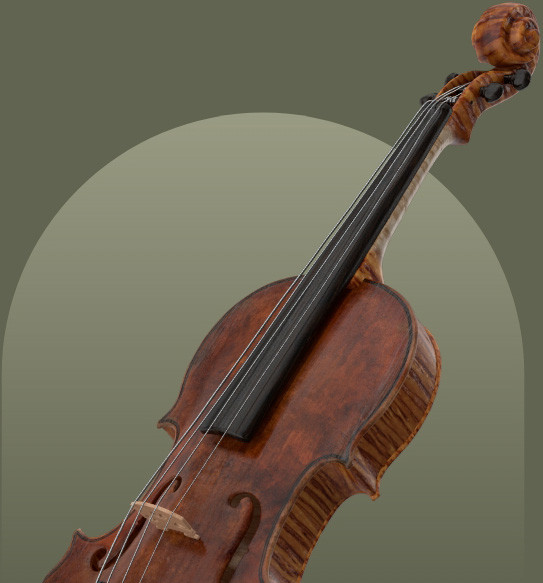John Dilworth
GUARNERI, Pietro (I) Born 1655 Cremona, died 1720 Mantua Italy. Elder son and pupil of Andrea Guarneri, above. Active and identifiable in the instruments of the Guarneri workshop from about 1670, he left sometime after 1677 and was settled in Mantua by 1683, working both as a luthier and musician in the ducal court. His work there developed a unique and very disciplined style, apparently influenced by Stainer in the often very high archings, and with elegant narrow soundholes finished with large eyes at each terminus. The scroll is relatively heavy compared with the general delicacy of the rest of the work, with a large eye and strong chamfer. Pietro’s varnish is particularly fine even amongst his peers. It is deep red-brown, even and well-applied, virtually without textural flaws, and laid over a finely reflective golden ground. Most consider him to have been the best craftsman of the Guarneri family. He was important in founding the small but significant Mantuan school, and both its most highly regarded makers, Camillo Camilli and Tomasso Balestrieri, were very strongly influenced by him. Petrus Guarnerius Cremonensis filius Andreae / fecit Mantuae sub tit. Sanctae Teresiae 1685
George Hart
Son of Giuseppe filius Andrea. He followed to some extent the form of the instruments of his uncle Pietro, from whom, while in Mantua, he probably learnt his art. The work is very good, and his productions are well worthy of the Guarnerian name. The varnish is rich, but not so transparent nor so well laid on as to come up to the full standard. The scroll is rather weak.
Cecie Stainer
Eldest son of Andrea, b. Feb. 18, 1655, at Cremona; d. about 1740. He remained in Cremona till 1680, then went to Mantua; he visited Cremona for a few months in 1698 (the year of his father’s death), but returned to Mantua and probably lived there, 1700-40. Said to have been a pupil of Girolamo Amati.
His instruments differ from those of his father and brother, but he used their labels for the violins made before he had left Cremona. His work shows great originality; his violins are on a large pattern, very arched, made of good wood, that of the bellies being wide in grain and very even; the breadth between the sound-holes is increased and the corners are delicately worked; the purfling excellent; the scroll very characteristic; the transparent varnish, of beautiful rich quality, either warm yellow or pale red colour ; the tone is full, but lacks brilliancy.
The violoncellos he made when in Mantua are often of exaggerated form, and were intended for use in processions, the performers having them suspended round the neck.
His work, generally excellent, had some serious defects. Though quite correctly making the backs and bellies of his violins of equal thicknesses, he made them too thin, which rendered the tone veiled and dull, and also gave too much flexibility to the instrument, so that the tension on the strings is great, it is difficult to keep them up to pitch, and they are liable to break. His instruments, however, are much valued.
Labels: “Petrus Guarnerius Cremonensis fecit Mantuai sub. tit. Sanctae Teresiae, 1695,” similar ones are dated 1690 and 1710;
and ” Revisto e corretto da me Pietro Guarneri Cremonese in Mantova, 1697.”
In 1677 he married Caterina Sussagni; had one son, Andrea Francesco, b. Jan. 29, 1678, who was not a violin maker.
Willibald Leo Lütgendorff
Erstgeborner Sohn von Andrea G., bei dem er bis 1680 blieb, nachdem er
sich schon 1677 mit Caterina Sussagni verheirathet hatte. Später liess er sich
in Mantua nieder und kam nur noch einmal im Jahre 1698 nach Cremona
zurück, wahrscheinlich veranlasst durch die schwere, mit dem Tode endigende
Krankheit seines Vaters. In dieser Zeit arbeitete er für seinen Bruder Giuseppe.
Dass er zuletzt in Venedig ansässig gewesen und dort ganz herunter gekommen
sein soll, beruht wohl auf einer Verwechslung mit seinem Neffen Pietro (II.).
Man wollte ihn früher für einen Amati-Schüler halten, doch hat er wahrscheinlich
bei seinem Vater gelernt. Er war ein sehr begabter Geigenmacher, aber
ein etwas unruhiger Geist, was ihn verhindert haben mag, voll auszureifen. In
der Form weichen seine Geigen bedeutend von denen seines Vaters und Bruders
ab, ja er machte sogar Versuche, neue Formen zu finden, wofür eine noch erhaltene
Alt-Viola von 1698 spricht, bei der er die Ecken weggelassen hat, also
dasselbe that, was später u. A. Chanot gethan hat, der eine ganz neue Erfindung
damit gemacht zu haben glaubte. Sonst ist sein Modell sehr schön und gross,
die F-Löcher sind breit und rund und halten die Mitte zwischen Amati und
Stradivari, während die )( mehr an Nic. Amati erinnern; die Schnecke ist breit
und hat einen originellen Zug, und die Einlagen sind sehr schön. Die Wölbung
nahm er bei breiter Brust ein wenig zu hoch, wesshalb auch der Ton seiner
Geigen, so edel er an sich genannt werden muss, oft nicht allzu gross ist. Das Holz
ist in der Regel sehr schön und der blassrothe oder braungelbe Lack vortrefflich.
Seine Arbeit ist manchmal barock und nicht immer sehr genau, und wenn
dies bei ihm die Schönheit des Tons nicht beeinträchtigt, so scheinen die Recht
zu haben, die behaupten, dass es doch ein Geheimniss der Cremoneser gab, von
dem eben der Ton abhängig war. Eine aus Venedig datirte Violine von ihm
sah der Geigenmacher Methfessel vor einigen Jahren in Wien.
